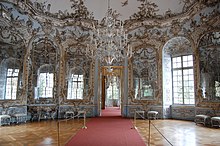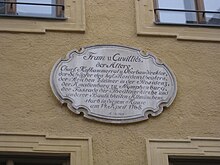François de Cuvilliés the Elder
François de Cuvilliés the Elder (born October 23, 1695 in Soignies , Hainaut , Belgium, † April 14, 1768 in Munich ) was a master builder , sculptor , plasterer and ornament maker as well as a Bavarian court master builder. Trained mainly in Paris, he is one of the grand masters of the German Rococo .
His name is often written in the Germanized form Cuvillies . He was the father of François de Cuvilliés the Younger .
life and work
Cuvilliés came from the former Hainaut in Wittelsbach. 1708 he joined as a court jester in the service of the Elector Max II. Emanuel of Bavaria, who had to live at this time in exile. After traveling through France in the wake of the elector, Cuvilliés also accompanied him on his return to Munich in 1714.
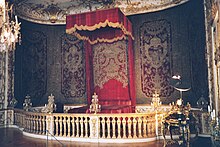
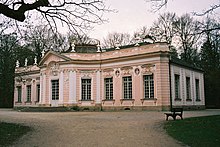
Cuvilliés was trained with Joseph Effner and from 1720–1724 at the Paris Académie royale d'architecture . In 1725 he got the office of court architect at the electoral court. It was not until 1728 that Cuvilliés' subordinate position changed. The new elector equated Cuvillié's instructions with those of Effner. From 1730, Elector Karl Albrecht transferred all new orders directly to Cuvilliés. Effner and Gunetzrhainer get nothing. Cuvilliés, who spoke bad German, was not employed in the administration.
In Munich he worked at the Palais Piosasque de Non from 1728 , from 1730 to 1737 on the rich rooms of the Munich Residence (badly destroyed in the Second World War, but reconstructed using salvaged original parts until 2001), from 1733 to 1737 at the Palais Holnstein , from 1734 to 1739 at the Amalienburg in the park of Nymphenburg and 1743 to 1749 at Haimhausen Castle . From 1732 to 1739 Cuvilliés also helped build the collegiate church in Dießen am Ammersee (headed by Johann Michael Fischer ).
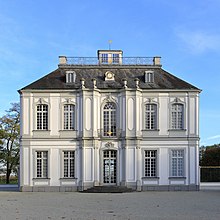
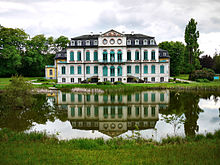
Cuvilliés was also active outside of Bavaria; in Kurköln, which was ruled by the Wittelsbach family, he played a key role in the construction of the Augustusburg and Falkenlust palaces (1728 to 1740). The Falkenlust hunting lodge was set up as a maison de plaisance and, in contrast to Augustusburg Palace with its representative claim, gave its rooms a private, homely and intimate character (Chinoises lacquer cabinet). In Hesse, which was closely allied with spa Bavaria, he worked on Wilhelmsthal Castle (1744).

In contrast to his predecessors, Elector Max III was. Joseph tried to reduce the debt burden from 1745 and was therefore not ready to sponsor large new building or art projects. For Cuvilliés, who hadn't been paid a salary since 1742, the court's financial difficulties are just one evil. Since 1738 he has only been listed as a master builder, and in 1745 Johann Baptist Gunetzrhainer was appointed master builder. The reasons for the resignation of Cuvillié are his lack of knowledge of German, lack of presence in the court building office and also his apparently health aversion to the necessary travel activity. He preferred to be at home and draw. From 1750 to 1753, however, the residence theater ( Cuvilliés theater ) was built after a fire . The theater was destroyed during the war in 1944, but the interior furnishings that had been relocated during the war were reinstalled elsewhere in the residence and given a new look; the former court theater has since been officially named after its architect.
1755–1756 he took over elements of classicism and the Italian ornamental forms during his second stay in Paris and when he attended the architecture school of Jacques-François Blondel, which was shaped by the Régence in France . However, the Bavarian component dominates, so that he is counted among the grand masters of the German Rococo . The ingenuity of his floor plan solutions, the elegance of his splendid decorations, the combination of fantasy with subtle taste, is unsurpassed. After returning to the court in Munich, Cuvilliés was called in in 1756 to redesign the main building of Nymphenburg Palace . From 1756 he also worked at Sünching Castle . In 1758 he still designed the stucco for the billiard room in the New Schleissheim Palace . Cuvillié's last work was the completion of the facade of the Theatinerkirche St. Kajetan opposite the Residenz in Munich (1765/68).
Between 1738 and 1756 he published more than fifty books on the interior decoration of rooms and on design elements such as wall panels, ceilings, furniture and wrought iron decorative objects. The engravings in these books helped spread the rococo taste and style across Europe. For Dresden, Cuvilliés drafted a plan to redesign the Zwingergarten around 1759 , including the construction of a new residential palace, which was not implemented.
With the Castrol stove (or pot stove ; the name Castrol is derived from the French word casseroles = cooking pots), Cuvilliés designed the first stove with a closed fire box and an overhead, perforated stove plate (installed around 1735 in the kitchen of the Amalienburg in the Nymphenburg palace park ).
Major works
- Augustusburg Castle and Falkenlust, Brühl (World Heritage Site) (1728–1740)
- Palais Piosasque de Non in Munich (1729)
- Expansion of the Munich residence, including the rich rooms (1730 to 1733/37)
- Palais Holnstein in Munich (1733–1737)
- Amalienburg in Nymphenburger Park (1734–1739)
- Haimhausen Castle (1743 to 1749)
- Wilhelmsthal Castle in Calden near Kassel (1744)
- Construction of the Residenztheater in Munich ( Cuvilliés Theater ) (1750–1753)
- Facade of the Theatiner Church, Munich (1768)
literature
- Hermann Neumann (ed.): Preserving and researching. The restoration of the Cuvilliés Theater in the Munich Residenz and new insights into early building history . Munich 2016, ISBN 978-3-943866-40-7
- Dietmar Hundt, Elisabeth Ettelt: F. Cuvilliés d. Ä., F. Cuvilliés d. J. Pannonia, Freilassing 1990, ISBN 3-7897-0139-4 ( Kleine Pannonia-Reihe 139).
- Andrea Rueth: François de Cuvilliés d. Ä. In: Jürgen Wurst, Alexander Langheiter (Ed.): Monachia. By Carl Theodor von Piloty in the Munich City Hall. Städtische Galerie im Lenbachhaus, Munich 2005, ISBN 3-88645-156-9 , pp. 106-107.
- Johannes Schnell: François de Cuvilliés' School of Bavarian Architecture. A contribution to the engraving and the architectural theory of both Cuvilliés. Munich 1961 (Munich, Univ., Diss., 1961).
- Gerhard Woeckel: Cuvilliés, Jean François Vinzent Joseph de. In: New German Biography (NDB). Volume 3, Duncker & Humblot, Berlin 1957, ISBN 3-428-00184-2 , p. 452 f. ( Digitized version ).
- Albrecht Vorherr (ed.): François de Cuvilliés: Rococo designer at the Munich court. Munich 2018, ISBN 978-3-96233-022-4 .
- Friedrich Wolf: François de Cuvilliés - The architect and decor creator. Series: Obb. Archive, ed. from histor. Association of Obb. (Munich City Archives), 89th vol., 1967. 128 pp. With part of illustrations.
Individual evidence
- ↑ Sueddeutscher-Barock, François de Cuvilliés the Elder. Retrieved March 3, 2018 .
- ↑ Sueddeutscher-Barock, François de Cuvilliés the Elder. Retrieved March 3, 2018 .
Web links
- Mirrors, stucco and mountains of debt: Rococo in Bavaria. TV film on the occasion of the 250th anniversary of François de Cuvilliés' death . BR , broadcast on April 2, 2018.
- François de Cuvilliés in BR Heimat , BR , broadcast on June 11, 2018.
| personal data | |
|---|---|
| SURNAME | Cuvilliés, François de the Elder |
| BRIEF DESCRIPTION | German builder and ornament maker |
| DATE OF BIRTH | October 23, 1695 |
| PLACE OF BIRTH | Soignies , Hainaut, Belgium |
| DATE OF DEATH | April 14, 1768 |
| Place of death | Munich |
